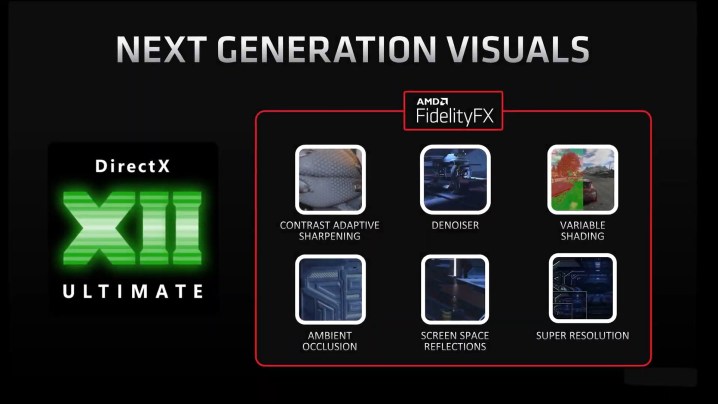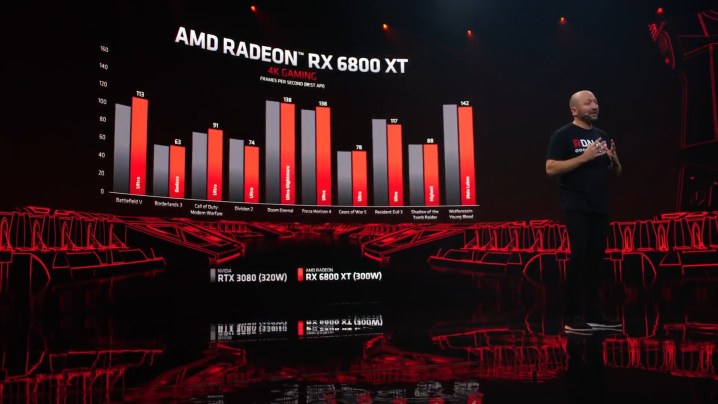With its latest Radeon RX 6000 series graphics cards, AMD not only is making a triumphant return to the high-end gaming space, but it is setting itself up as a formidable challenger to rival Nvidia. Though the cards use the same 7nm manufacturing process as the prior-generation RDNA cards, AMD made significant changes to its RDNA 2 microarchitecture this year to deliver major performance improvements.
With 54% performance-per-watt gains over the prior generation, support for ray tracing, and better power efficiency, the Radeon RX 6800 XT is a great alternative for gamers who may have been looking at the Nvidia GeForce RTX 3080. The more affordable Radeon RX 6800 is designed to take on the RTX 3070.
Design

AMD’s latest GPUs are striking, and not just in their industrial black plastic and metal-clad aesthetics, but also due to their sheer size. Comprised of three fans, an aluminum heat sink, and a PC board that spans the entire length of the card, AMD is taking a more conservative approach to its GPU design than what rival Nvidia did for its GeForce RTX 3080 and 3090 card.
The liberal use of metal in the construction gives the card a reassuringly sturdy feel. Aluminum is used on the backplate, the shroud, and the frame, as PC Mag UK discovered. On the bottom, you’ll find three fans in a push-pull arrangement. You won’t find any new connectors on AMD’s design with RDNA 2 — dual eight-pin connectors deliver 300 watts of power to the XT variant (or 250 watts to the non-XT RX 6800). The big generational difference is that AMD had slimmed down the number of ports on this year’s card, and the RTX 6800 XT comes with two DisplayPort 1.4b ports, one HDMI 2.1 port, and one USB-C port.
Performance

To see how all the performance that AMD claims you’ll be getting with its Big Navi architecture was squeezed in, you’ll have to look inside the card. The RX 6800 ships with 60 compute units and the same number of ray accelerators, 3,840 stream processors, and a boost speed of 2,105 MHz. The RX 6800 XT has 72 compute units and the same number of ray accelerators, 4,608 stream processors, and a boost speed of 2,250 MHz.
And just for reference on what AMD could achieve with its small 7nm die, the enthusiast-class RX 6900 XT comes with 80 compute units and 26 billion transistors, a massive jump compared to the 28 million transistors on Nvidia’s RTX 3090, which comes packaged in a larger Samsung 8N node.
And despite staying with a 256-bit bus, AMD’s use of a new Infinity Cache this year allows the RDNA 2 microarchitecture to squeeze still more bandwidth, even when compared to standard GDDR6 memory with a larger 512-bit bus. For comparison, Nvidia’s high-end RTX 3080 and RTX 3090 GPUs pair its 320-bit and 384-bit buses with new GDDR6X memory to deliver performance, but the downside to that solution, according to PC World, is you’ll see higher power draw and more latency.
Infinity Cache is based on the L3 cache that AMD used on its Epyc servers, and the 128MB L3 cache has been made specifically to handle gaming needs. Compared to the L3 SRAM memory on Epyc processors, PC World said that the Infinity Cache is four times denser, which helps power efficiency. With larger bandwidth, reduced latency, and the ability to go to higher clock speeds, Infinity Cache helps these processors achieve 4K gaming, ray tracing, and applications that rely heavily on memory.
With Infinity Cache, it appears that AMD has underpromised and overdelivered in terms of clock speed. When Forbes benchmarked the RX 6800 XT using Forza Horizon 4 in a series of sequential benchmarks to see how the GPU will perform once it’s hot, the publication found that the card ran at 2,340 MHz, or nearly 100 MHz faster than the boost speed that AMD had promised.

If you need more performance, you can turn to AMD’s Radeon Software to easily overclock your card. With overclocking enabled, PC Mag was able to reach a stable boost speed of 2,800 MHz, which resulted in a 10% performance uplift in titles like Assassin’s Creed: Odyssey. Overclocked, the RX 6800 XT performed nearly 10 frames per second (fps) faster than the stock RTX 3080, the publication noted.
For standard video memory, AMD is equipping its cards with 16GB of GDDR6 RAM, making it more future-proof than the paltry 10GB of memory on the RTX 3080.
In synthetic performance, the RX 6800 and RX 6800 XT are very competitive. If you’re upgrading from an older card, Forbes’ 3DMark Fire Strike tests show that both cards perform significantly better than the AMD RX 580 and the Nvidia GTX 1080. Both RX 6000 cards also performed better than newer cards, like the RX 5700 XT and the RTX 2080 Super. The results showed that the RX 6800 XT also edged ahead of the RTX 3080, while the Radeon RX 6800 trailed behind the Nvidia card by a small margin. The publication noted that this year’s XT variant got a 312% uplift from the RX 580 and a 93% boost when compared to the RX 5700 XT.
In other synthetic tests, Hot Hardware found that performance between Nvidia’s RTX 3080 and the RX 6800 XT were very similar. The Radeon edged ahead of its rivals in tests like Fire Strike, Time Spy, and SiSoft Sandra 2020, but the GeForce RTX 3080 performed slightly better in tests like LuxMark 4.0, IndigoBench, Unigine Superposition, and VRMark, for example. In general, though, most users won’t have much to complain about with standard creative workloads when choosing any of the latest GPUs.
Ray tracing

Because of AMD’s implementation of ray tracing, the latest Radeon cards weren’t nearly as powerful as Nvidia’s 3000 series RTX cards. AMD leverages its Infinity Cache to squeeze out more performance when
This dip in performance is noticeable in Hot Hardware’s ray-tracing benchmarks, with the Radeon RX 6800 XT performing 23% less than the RTX 3080 in the Crytek Neon Noir using the Ultra preset at 1440p. The performance gap widens when you step up to 4K UHD resolution, as the GeForce increases its lead by nearly 29%.
In Forbes’ use of the 3DMark DirectX Ray Tracing benchmark, the RTX 3080 performed at 48.1 fps, whereas the Radeon RX 6800 XT dropped to just 26 fps, which is still higher than the 22 fps on the prior-generation RTX 2080 Super. Surprisingly, the Radeon RX 6800’s 21 fps performance isn’t too far behind, but these benchmarks confirm that AMD needs its own DLSS alternative to be truly competitive.

In actual games, like Shadow of the Tomb Raider, Forbes found that the drop in frame rates was present, but wasn’t as drastic as the synthetic benchmarks would have you believe. The game played at 151 fps in 1440p with ray tracing disabled on the RTX 3080, and just 97 fps with
In the future, however, AMD’s forthcoming Fidelity FX Super Resolution could become a competitor to Nvidia’s DLSS, and the solution could see more widespread adoption given that the RDNA 2 architecture is also found on Microsoft’s new Xbox Series X and Sony’s PlayStation 5 consoles.
For general gaming without ray tracing, the RX 6000 series achieves AMD’s promise of 4K gaming at 60 fps, at least with the higher-end 6800 XT and even with the 6800 in a number of titles. Id you’re coming from an RX 5700 XT, you’re going to see approximately double the frame ate by upgrading to the XT variant this year. On Borderlands 3 on
The performance here is consistent across a number of titles in 4K, with the RTX 3080 edging ahead of the RX 6800 XT in titles like Shadows of the Tomb Raider, while the RX 6800 XT holds an edge in others, like Dirt 5, according to Forbes. With Tomb Raider, if you’re coming from an older RX 480 card, upgrading to the RX 6800 XT will net you a huge 276% uplift in performance.
Early adopters, however, should be warned that performance with the Radeon cards may not be entirely consistent. PC Mag noted in its tests that there is a swing in performance by as much as 10% in either direction, and that first-day drivers may be to blame. As AMD updates its drivers and software, these cards will hopefully perform more consistently — and reliably — in the future. Despite these issues, multiplayer gamers will be happy to know that the RX 6800 XT was able to keep pace with Nvidia’s RTX 3080 in games like Counter-Strike: Global Offensive, Rainbow Six Siege, and Final Fantasy XIV, the publication noted.
Staying within Team Red’s ecosystem

If you’re a dedicated AMD gamer, pairing the latest Radeon RX 6000 series graphics with a Ryzen CPU will give you an advantage compared to gamers who want to use Intel for processing power. AMD is promoting its Smart Access Memory, which allows the CPU and GPU to share resources like memory. With Smart Access Memory enabled, you’re going to see anywhere between an 8% to 16% boost in frame rates in games ranging from Borderlands 3 and Hitman 2 to Forza Horizon 4, Forbes said.
Smart Access Memory will give AMD a competitive edge as games get more rich and detailed in the future.
In addition to Smart Access Memory, there are also a number of new technologies packed into the Radeon cards that are designed to give gamers even more performance. There’s support for DirectX 12 Ultimate and variable rate shading, and the cards also support Microsoft’s DirectStorage APIs, which means games load faster.
Conclusion
If you’re coming from an older graphics card, the Radeon RX 6800 and its XT variant are significant upgrades in terms of performance, with both delivering capable 60 fps gaming at 4K resolution. And with new support for ray tracing, AMD finally has a true competitor to rival Nvidia’s high-end GeForce cards, including the latest GeForce RTX 3080.
At $499, the Radeon RX 6800 is a curious proposition from AMD. While the card delivers a massive 50% generational performance uplift, it doesn’t quite match the ray-tracing capabilities of the competing RTX 3070. The more compelling upgrade is the $649 Radeon RX 6800 XT, which delivers impressive performance that keeps AMD competitive with Nvidia’s flagship RTX 3080.
Editors' Recommendations
- AMD just did Nvidia a serious favor
- Here’s how AMD counters Nvidia’s big RTX Super launch
- AMD has another new GPU that it says can beat the RTX 4060 Ti
- Nvidia gave AMD’s RX 7800 XT a free win
- AMD’s two new GPUs significantly undercut Nvidia



